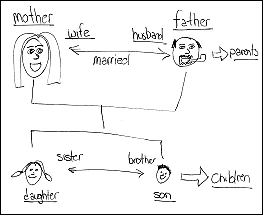| <<Back to Table of Contents Print |
||
 |
ACE English Program Lesson Planner |
| Teacher: | Level: | ACE – Low Beginner | |
| Skill: | Listening and speaking | Date: | May 29, 2006 |
| Subskills: | Topic: | Family and relationships | |
| Objective: | SWABAT: Identify family members in English. Draw a family tree based on auditory information. Answer tourists’ questions about their family in English. |
Lexis: | Mother, father, wife, husband, married, family tree, daughter, son, children, sister, brother |
| Language point(s): | “How many people are in your family?” “Are you married?” “How many children (sons, daughters) do you have?” “How many brothers and sisters do you have?” |
Anticipated problems: |
| STAGE | E | S | A | TARGET LANGUAGE | TEACHER | STUDENT | MATERIALS | TIME |
| 1 | E | Theme language | Places Family flashcards in front of class. Elicits key lexis. | Responds | Family flashcards: Married couple and family | 5 min |
| 2 | E | Theme language | Creates a family tree [1] as key lexis is elicited. | Responds | Whiteboard | 5 min |
| 3 | E | Theme language | Chooses a female volunteer. Gets down on knees and proposes. Points to self: “Husband.” Points to female, elicits wife. | Responds | None | 2 min |
| 4 | E | Theme language | Uses children flashcards to elicit “son,” “daughter,” “child,” … etc. | Responds | Children flashcards | 5 min |
| 5 | S | Theme Language | Pairs Ss. Hands out paper task 1. Ss complete page 1 alone or in pairs. | Completes task | Paper task 1 | 5 min |
| 6 | E/S | Theme language | Listening and Speaking: Sets the scene using family flashcard. Speaks dialog [2], then drills until Ss can say it when teacher points to speaker. | Listens, repeats. | Dialog flashcard | 5 min |
| 7 | S | Theme language | Pairs Ss. Have them complete paper task 1 (page 2). | Completes task | Paper task 1 | 5 min |
| 8 | E/S | Theme language | Listening and Speaking: Sets the scene using dialog flashcard. Speaks each piece of dialog [3]; Ss listen, then repeat. Once drilled, model each piece with the corresponding family tree on the whiteboard. | Responds | Dialog flashcard, whiteboard | 10 min |
| 9 | S/A | Theme language | Listening: Reads dialog [4]. Repeats as many times as necessary. Ss draw corresponding family tree. | Draws family tree. | Paper, pens | 10 min |
| 10 | S/A | Theme language | Gives each Ss a piece of tape and has them tape their family trees to the window. Teacher then reads dialog [4] again and draws the family tree on the whiteboard. | Compares their family tree to the correct answer. | Tape, whiteboard | 5 min |
| 11 | S/A | Theme language | Hands out paper task 2 (page 3 of PT1). Ss answer each question alone, and then draws their own family tree. | Answers questions, draws family tree | PT2 (PT1 page 3) | 10 min |
| 12 | A | Theme language | Ss take turns coming to the front of the room. Ss1 asks the questions form dialog [3] and the other replies. Then they switch. Teacher corrects for errors after Ss have finished. | Responds. | PT2, chairs | 20 min |
| NOTES: |
| Pre-Lesson: [1] 
[2] [3] [4] Post-Lesson: Overall a decent lesson. I was literally running on one hour of sleep when I taught it (and I still am), which surely choked its potential. Teacher wasn’t as effective as possible at monitoring and correction; bad craic as the emphasis of this lesson was pronunciation and conversation. Eliciting was successful and creative. Proposing to female Ss got some laughs and highlighted differences between father/mother and husband/wife. For correction of PT1 page 1 I drew the family tree and had Ss come to the board and fill in missing words. Many Ss knew the lexis but pronunciation and language was a struggle for most of them. Some of the dialog wasn’t reinforced enough. Some necessary dialog for the final activation wasn’t pre-taught effectively (i.e., I have no children, I have no daughters, etc.) but was elicited and Ss grasped it (lesson plan was altered in section B and all responses were properly modeled and drilled in stage 8). Activation was lame; changed it in section B so that each Ss drew a family tree and answered the questions in PT2. Somewhat less lame, but the drawing was time-consuming and Ss relied too much on their notes instead of natural speaking. ELLP Report: This lesson is not applicable—there is no chapter on family in the ELLP manual. |
| ^ Top |